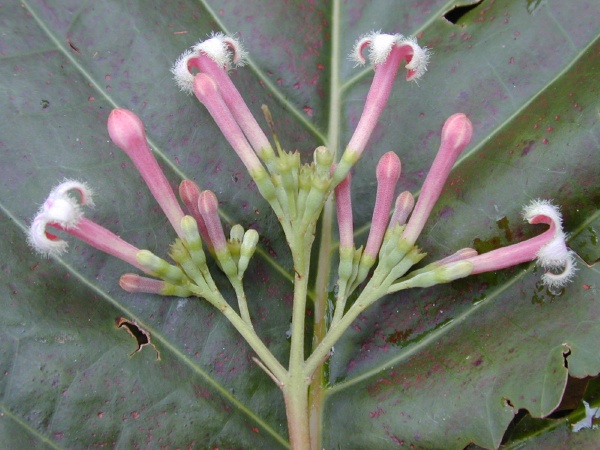Reproduction
The light-weight seeds of Cinchona pubescens are
distributed by the wind or also by animals. The seeds have been
discovered to be able to distribute themselves to expand the
species up to about 95 meters per year! The
 tree grows on an
average of 1-2 meters per year and produces seeds when it is
four years old. It is also able to produce suckers from the
root area, and re-sprouts in areas of the root that are
damaged. The speedy growth of the tree enables it to take over
the local vegetation. This rapid takeover of vegetation usually
occurs in areas that have no trees growing. Shrub and herb
plants are the species of vegetation that suffer the most
because of the inability to grow underneath the tree’s very
dense canopy.
tree grows on an
average of 1-2 meters per year and produces seeds when it is
four years old. It is also able to produce suckers from the
root area, and re-sprouts in areas of the root that are
damaged. The speedy growth of the tree enables it to take over
the local vegetation. This rapid takeover of vegetation usually
occurs in areas that have no trees growing. Shrub and herb
plants are the species of vegetation that suffer the most
because of the inability to grow underneath the tree’s very
dense canopy.
The angiosperm life cycle alternates between a dominant diploid sporophyte generation and a haploid gametophyte generation. The male parts of the flower consist of the stamen, filament, and anther. The stamen is made up of the filament (stalk) and the anther (tip of stalk). The carpel, ovary, style, and stigma make up the female parts of the flower. The carpel contains the ovary, style, and stigma. The ovary is at the lower end and is where the seeds are produced. The style is stalk-like and has a stigma at the tip of it. The stigma is sticky and is the region where the pollen lands.
The anthers, which are composed of microsporangia,
produce microspores via meiosis. The microspores
develop into male gametophytes or pollen. The
ovaries, on the other hand, are composed of
megasporangia
 which produce megaspores by meiosis.
The megaspores develop into female gametophytes and
eventually into eggs. Since there are microspores
and megaspores on the same plant, the sporophytes of
angiosperms are considered to be heterosporous. The
gametophytes are therefore unisexual. In the case
of C. pubescens, the pollen is transferred
to the stigma of the carpel by wind or animals.
This process is called pollination. Uniting of the
sperm nucleus and egg nucleus is referred to as
fertilization. Uniting the haploid egg and haploid
sperm creates the zygote. The zygote then develops
into the embryo which is nourished by its
endosperm. The seed germinates and develops into a
mature sporophyte.
which produce megaspores by meiosis.
The megaspores develop into female gametophytes and
eventually into eggs. Since there are microspores
and megaspores on the same plant, the sporophytes of
angiosperms are considered to be heterosporous. The
gametophytes are therefore unisexual. In the case
of C. pubescens, the pollen is transferred
to the stigma of the carpel by wind or animals.
This process is called pollination. Uniting of the
sperm nucleus and egg nucleus is referred to as
fertilization. Uniting the haploid egg and haploid
sperm creates the zygote. The zygote then develops
into the embryo which is nourished by its
endosperm. The seed germinates and develops into a
mature sporophyte.
Below is a diagram of the basic angiosperm life cycle. For a more specific summary of the angiosperm life cycle, visit Angiosperms Reproduction and Life Cycle.
Now that you have a better grasp of C. pubescens itself, go to Medicinal Uses to learn more about how the tree is beneficial to US!
Home is where I'd rather be.
